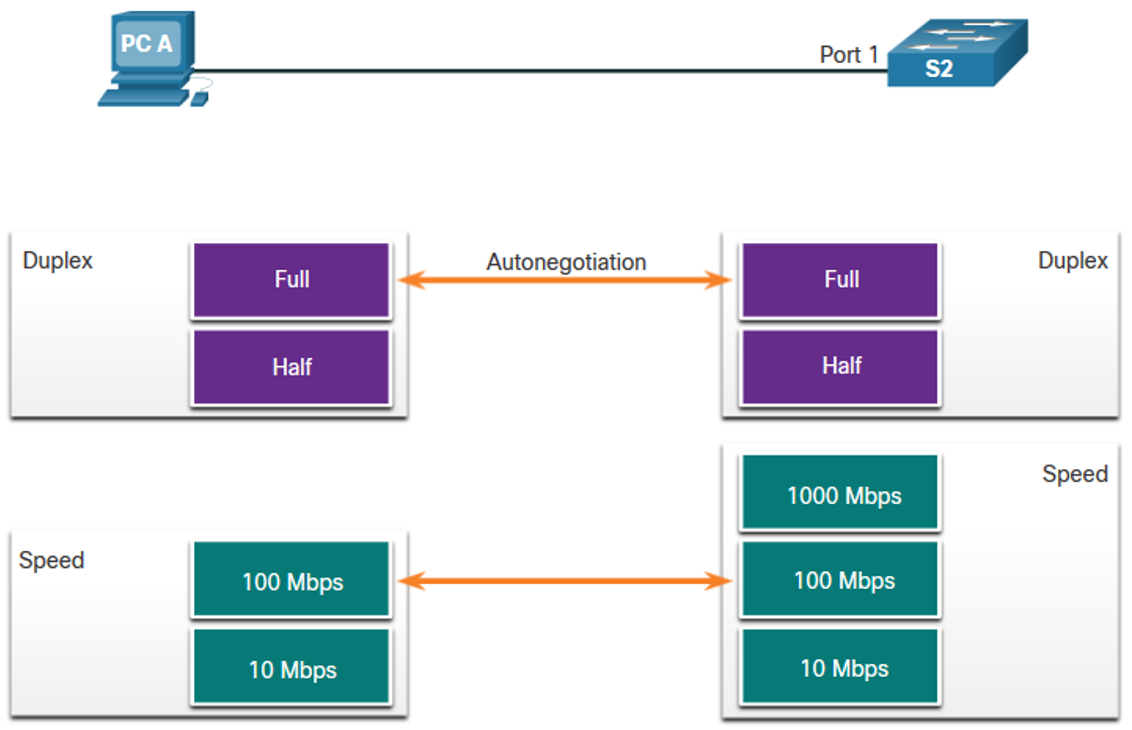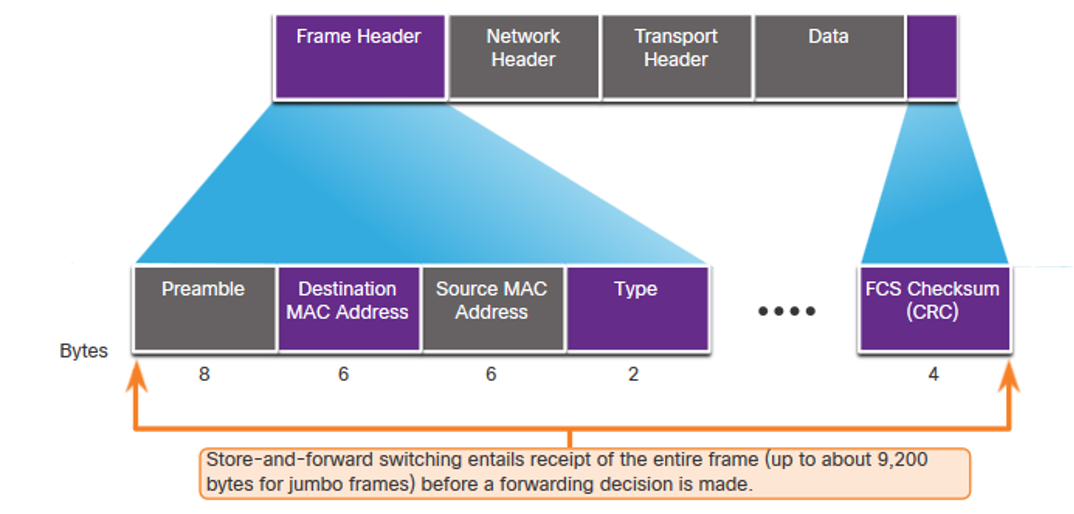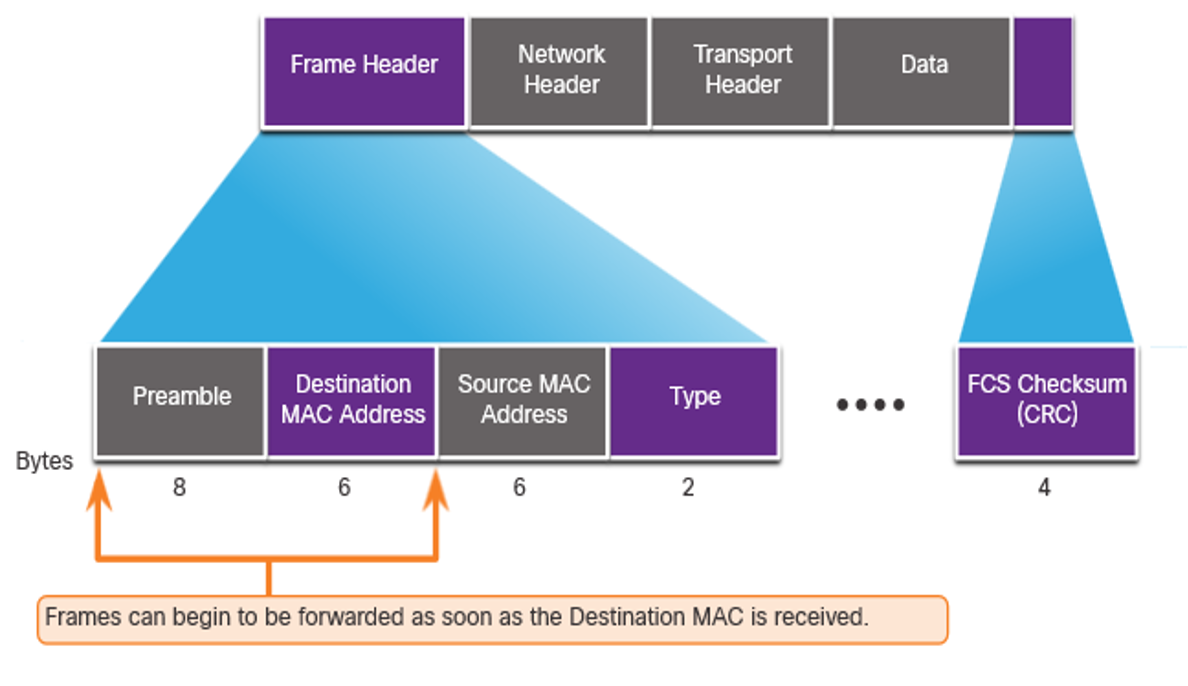
Switching Concepts
Module Objective: Explain how Layer 2 switches forward data.
| Topic | Objective |
|---|---|
| Frame Forwarding | Explain how frames are forwarded in a switched network. |
| Switching Domains | Compare a collision domain to a broadcast domain. |
2.1 Frame Forwarding
Switching in Networking
Two terms are associated with frames entering or leaving an interface:
- Ingress – entering the interface
- Egress – exiting the interface
A switch forwards based on the ingress interface and the destination MAC address. A switch uses its MAC address table to make forwarding decisions.  Note: A switch will never allow traffic to be forwarded out the interface it received the traffic.
Note: A switch will never allow traffic to be forwarded out the interface it received the traffic.
The Switch MAC Address Table
A switch will use the destination MAC address to determine the egress interface. Before a switch can make this decision it must learn what interface the destination is located. A switch builds a MAC address table, also known as a Content Addressable Memory (CAM) table, by recording the source MAC address into the table along with the port it was received.
The Switch Learn and Forward Method
The switch uses a two step process: Step 1. Learn – Examines Source Address
- Adds the source MAC if not in table
- Resets the time out setting back to 5 minutes if source is in the table
Step 2. Forward – Examines Destination Address
- If the destination MAC is in the MAC address table it is forwarded out the specified port.
- If a destination MAC is not in the table, it is flooded out all interfaces except the one it was received.
Switch Forwarding Methods
Switches use software on application-specific-integrated circuits (ASICs) to make very quick decisions. A switch will use one of two methods to make forwarding decisions after it receives a frame:
- Store-and-forward switching – Receives the entire frame and ensures the frame is valid. Store-and-forward switching is Cisco’s preferred switching method.
- Cut-through switching – Forwards the frame immediately after determining the destination MAC address of an incoming frame and the egress port.
Store-and-Forward Switching
Store-and-forward has two primary characteristics:
- Error Checking – The switch will check the Frame Check Sequence (FCS) for CRC errors. Bad frames will be discarded.
- Buffering – The ingress interface will buffer the frame while it checks the FCS. This also allows the switch to adjust to a potential difference in speeds between the ingress and egress ports.

Cut-Through Switching
Cut-through forwards the frame immediately after determining the destination MAC. Fragment (Frag) Free method will check the destination and ensure that the frame is at least 64 Bytes. This will eliminate runts. Concepts of Cut-Through switching:
- Is appropriate for switches needing latency to be under 10 microseconds
- Does not check the FCS, so it can propagate errors
- May lead to bandwidth issues if the switch propagates too many errors
- Cannot support ports with differing speeds going from ingress to egress

2.2 Switching Domains
Collision Domains
Switches eliminate collision domains and reduce congestion. When there is full duplex on the link the collision domains are eliminated. When there is one or more devices in half-duplex there will now be a collision domain.
- There will now be contention for the bandwidth.
- Collisions are now possible.
Most devices, including Cisco and Microsoft use auto-negotiation as the default setting for duplex and speed. 
Broadcast Domains
A broadcast domain extends across all Layer 1 or Layer 2 devices on a LAN.
- Only a layer 3 device (router) will break the broadcast domain, also called a MAC broadcast domain.
- The broadcast domain consists of all devices on the LAN that receive the broadcast traffic.
When the layer 2 switch receives the broadcast it will flood it out all interfaces except for the ingress interface. Too many broadcasts may cause congestion and poor network performance. Increasing devices at Layer 1 or layer 2 will cause the broadcast domain to expand. 
Alleviated Network Congestion
Switches use the MAC address table and full-duplex to eliminate collisions and avoid congestion. Features of the switch that alleviate congestion are as follows:
| Protocol | Function |
|---|---|
| Fast Port Speeds | Depending on the model, switches may have up to 100Gbps port speeds. |
| Fast Internal Switching | This uses fast internal bus or shared memory to improve performance. |
| Large Frame Buffers | This allows for temporary storage while processing large quantities of frames. |
| High Port Density | This provides many ports for devices to be connected to LAN with less cost. This also provides for more local traffic with less congestion. |